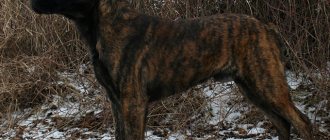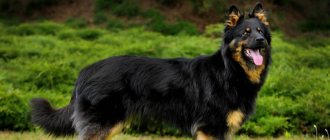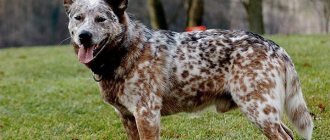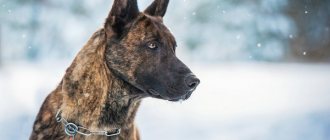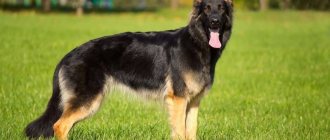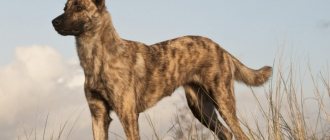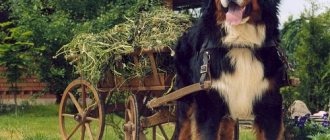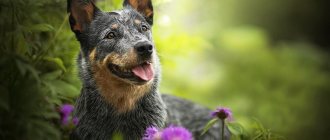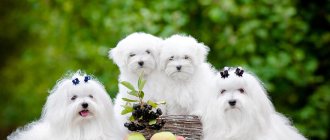Before you become interested in the history of the emergence of herding dogs, you need to understand why this name is associated with a number of breeds. “Shepherd” is derived from the word herd, that is, to guard, protect livestock.
Cattle have always been the main source of food for their owners, providing people with durable scraps of leather and serving for transporting heavy things. Such a valuable farm needed adequate protection from frequent attacks by wild animals. It was for this purpose that the owners kept and raised herding dogs.
History of origin
Asia is considered the ancestor of herding breeds. The first “shepherds” appeared a couple of thousand years ago among the inhabitants of nomadic tribes. The dogs protected them from wolves, bears and other uninvited guests. These dogs were improved and trained in any professional skills much later in Europe.
Over time, it became obvious that the main properties (large size and harsh character) were clearly not enough for herding breeds. Significant work was required on the color of the dogs, because the domestic pet had to be very different from wild animals, so as not to inadvertently get hooked by the owner at night. To achieve results, the first herding dogs began to be crossed with other European breeds.
In addition to European countries, Rome made a significant contribution to the development of breeds. Its inhabitants tried to train dogs in harsh fights with predators.
Collie (Scottish Sheepdog)
This Scottish Shepherd has a body structure that is different from other breeds - an elongated narrow muzzle, a proportional light body and long beautiful hair. The breed originated in Scotland, hence its name. This breed is always taken to any canine sports competition - it demonstrates excellent endurance, strength and agility.
Did you know? "Colli" means "helpful" in Gaulish.
Collies are medium in size, weighing no more than 25 kg. They are well suited for guarding small livestock . The color spectrum is varied - almost all colors. This breed is very hardy - the dog can run all day and not get tired. Ranks fourth in the ranking of the smartest dogs.
Some collies have a mutation in a certain gene that makes them sensitive to antibiotics and steroids. If the mutation progresses, the dog usually does not live more than six months.
Collies get along well with children and other animals and do not show aggression or hostility. They require mandatory care for their coat - it needs to be combed regularly. They are unpretentious in nutrition and can eat almost any food. They are very peaceful and friendly, but sometimes they like to be lazy - such character traits must be taken into account when training collies.
Learn more about hunting dog breeds: part 1, part 2, part 3, part 4, part 5.
Pros and cons of herding dogs
The list of advantages of herding dogs over other breeds is quite impressive:
- Proportional and beautifully formed physique.
- Well-developed bone structure and muscles that can withstand intense physical activity.
- Thick coat and undercoat, designed for the harsh climate of the highlands or the north.
- There is no hunting instinct, so the dog protects the herd and does not attack it.
- An intuitive sense of danger when a stranger appears, does not trust and checks everyone who enters the house.
- Loyalty to one master.
Each breeder can name one of the disadvantages of keeping a shepherd dog. For example, if you raise such breeds in an apartment, then a clear disadvantage for neighboring residents will be the loud and strong barking of the dog. In addition, several tens of meters of a city apartment are too cramped for these breeds. They are accustomed to a free life; space and frequent walks in the fresh air are important to them. Otherwise, various diseases are often detected in herders.
They are often quite large and seemingly aggressive dogs, so there is no need to leave them alone with strangers. If the “shepherd” was raised with children from infancy, then most likely there will be no danger to the surrounding children, but it’s still not worth the risk. Therefore, the shortcomings of each individual are considered separately, based on upbringing and environment.
Border Collie
This British dog breed is, according to research, the smartest dog breed in existence. The Collie is also called the English Sheepdog or Farmer's Collie - and indeed, in appearance the breed is similar to a mixture of a traditional Sheepdog and a Collie. The dog is of medium size and not very powerful muscles - however, despite this, it has become famous as an excellent herding dog. Herding and protecting the herd is her favorite pastime. She is very active and resilient - a border collie can cover up to 80 km a day over hilly terrain. The dog reacts very sensitively to all the orders of the shepherd, it concentrates its attention on all members of the herd, and thanks to its sensitive sense of smell, it detects danger from afar.
However, this breed has certain disadvantages. Since this is a pack animal that loves to be in company, it can chase any crowds: be it passing cars or children playing. This is due to her genetic predisposition to society, so you need to be understanding about this character trait. Occasionally, a border dog may be stubborn or disobedient - but this is only when it wants to attract the attention of its owner. In all other qualities, the dog is unmatched - its friendliness, devotion, loyalty, obedience and tolerance have made it one of the most popular dogs in the whole world.
Has the following characteristics:
- physique - graceful, medium size. The head is small, but quite wide. The length of the forehead and the entire muzzle are the same - this is a distinctive feature of the breed. The tail is low, of moderate length, the paws are oval, the limbs are well developed;
- The coat is medium length or short. The coat is quite tough and protects well from moisture and bad weather. The color may vary - however, mostly dark colors;
- character and type of behavior - an active, impetuous, agile and energetic breed. Very receptive, insightful, understanding and smart. Maintaining such high performance in collies requires constant mental training;
- weight and size - in adult breeds the weight does not exceed 20 kg, and the average height at the withers is 25-35 cm.
Border collies are perfect for young active owners , as well as families with children. This English Cattle Dog performs well in various sporting competitions.
For a collie to live comfortably, daily walks (or rather, even jogging) are necessary - otherwise, the dog may get sick. Borders are unpretentious when it comes to food—they love boiled chicken and broth-based porridge.
TOP 33 herding dogs
Among the prominent representatives of the shepherd group are:
Australian Shepherd (Aussie)
The USA is considered the country of origin of Aussies. An adult male weighs up to 30. The height at the withers reaches 55 cm. On average, they live 13-15 years.
Because of its easily trainable disposition, it is often used as a guide or service dog. They are friendly both towards people and other animals. At the same time, having offended an Aussie, a person will quickly receive a rebuff. A breed that requires daily physical activity. When keeping an Australian Shepherd in an apartment, it needs to be walked often and for a long time.
Australian Kelpie
The breed is a cattle breed. The dog reaches 51 cm in height and up to 27 kg in weight. Life period 10-14 years. Bred in Australia, the Kelpie is quite hardworking. She is used to active work and is often used as a service dog. Hardy and adaptable, tolerates harsh climates well. It is not recommended to keep her in an apartment; she is accustomed to a free lifestyle and constant movement.
Externally, the shepherd kelpie is compared to a fox. Optimistic, affectionate and devoted. At the same time, the dog copes well with the role of a shepherd, powerful and dynamic. Well amenable to training.
Alabai (Central Asian Shepherd)
A native of the regions of Central Asia primarily performs the role of a guard and protector. The height of an adult male is at least 70 cm. Average weight is 50-60 kg. Life expectancy is 12-15 years.
An extremely independent dog, he will never betray himself for a piece of something tasty. She has absolute fearlessness and never attacks first. Loud barking and growling seem to warn the opponent that he better stop.
You need to raise an Alabai, as they say, “from the cradle.” At the same time, you should not beat or scold the puppy over trifles. This is a very capricious and touchy breed. It is advised to entrust her education to an experienced instructor.
The breed is unpretentious in care; the main thing for it is proper nutrition and cleanliness. For good health, Alabai needs regular physical activity and long walks.
Appenzeller Mountain Dog
The country of origin of the breed is Switzerland. The height of an adult reaches 58 cm, weight - 32 kg. Average life expectancy is 12-15 years. Belongs to the group of pinschers and mountain cattle dogs.
The Sennenhund has proven itself well in training. These are quite smart guards with a loud bark. When meeting a stranger, they are not the first to show signs of aggression. Hardworking and attentive, they can make independent decisions. Adapts well to life in an ordinary family with children. It is quite difficult for this representative of shepherds to live without movement. Furniture, shoes and clothes in the house can suffer from unspent energy.
You can keep a dog in a city apartment, but the Sennenhund feels comfortable and comfortable only in a private home. However, this breed is not kept on a chain in a booth or enclosure. This is a true friend and ally who should live with the owners.
White Swiss Shepherd - BShO
Switzerland is considered the birthplace of the white shepherd. The weight of an adult male reaches 40 kg. The height of the breed reaches 61 cm at the withers. On average, BShO lives 13-15 years.
A powerful and hardy dog with a “hot” temperament and “nerves of steel”. The outline is similar to the German Shepherd, only the color is different.
Behaves aggressively only in cases of obvious threat or danger. Affectionate and responsive, suitable for families with children. She treats strangers with extreme restraint, but at the same time reacts calmly to animals living in the same territory with her. The Swiss Shepherd is easy to train, it is smart and quick-witted.
Representatives of the BShO are often found in the service of law enforcement agencies, as a guide, watchman or rescuer. The breed is characterized by excellent endurance and requires regular exercise. It is better if the Swiss Shepherd is kept in the house, but if this is not possible, it can easily live in an apartment.
Belgian Shepherd
Country of origin: Belgium. The first mentions of this representative of shepherds appeared in 1891. The male of this group is not so large - up to 30 kg. The height at the withers reaches 66 cm.
Belgian Shepherds are distinguished by their watchdog qualities. They are fearless, bark loudly and carefully store the object entrusted to them. Dogs are very active, their walking should not be limited to walking. They need to run for at least an hour during the day.
The breed can be kept with other animals, with the exception of cats and small rodents. They are not as beloved by the Belgian Shepherd. The dog also behaves towards children. She calmly accepts their appearance nearby, but does not actively participate in games with them. Such a dog needs to be socialized and trained as early as possible. He is smart and trainable.
A beautiful and well-groomed appearance of a pet requires constant coat care. It is quite difficult for a novice dog breeder to cope with caring for such a friend.
Bergamasco or Bergamasco Shepherd Dog
Bergamasco comes from Italy. It grows up to 62 cm, its weight reaches 38-40 kg. Average life expectancy is 13-15 years. According to the FCI this is a herding and cattle dog.
Outwardly, Bergamasco looks quite dangerous. In practice, these are one of the most good-natured pets, they are devoted to their owner and are good with children. This is a real protector for the whole family.
The optimal living conditions for the Bergamasco Shepherd are considered to be a country house. Moreover, it is not at all necessary to put the dog on a chain; a few walks in the fresh air are enough for it.
Despite his stubborn character traits, he is well trained. The main thing is to show the purebred dog who’s boss in the house.
Bergamasco wool requires a lot of work and care. Mats should not be combed or trimmed. They serve as a kind of protective layer for the dog’s body, so they wash it only a few times a year. This procedure can only be done by a professional; it is quite difficult to properly process wool at home.
A country house is suitable for permanent residence of a Bergamasco. You can keep this breed in an apartment, but you will have to take it for long walks outside.
Bernese Mountain Dog
The Bernese Mountain Dog originated from Switzerland. The dog's weight reaches 50 kg, height - 70 cm at the withers. Sennenhunds live much shorter than other herding animals, only 8-10 years.
Despite the size of the dog, he can often be found in the city. The puppy reaches its adult state only by two years. He gets along well with other pets, and has a special love for cats.
Sennenhunds love attention and affection, but will not ask for petting on their own. Also with maintenance, they can walk on a leash, but they will not tolerate a chain. Thus, they show their character in everything.
They are not as smart as other types of shepherd dogs, but they learn to carry out certain commands quite quickly. Sometimes they can show not only character, but also stubbornness.
The thick and long coat sheds almost all year round. For good health, the dog needs long walks and physical activity.
Bobtail
FCI herding and cattle dog from Great Britain. Height reaches 60 cm, weight - up to 42 kg. On average, they live up to 15 years.
The ancestor of the bobtail is called the South Russian Shepherd Dog. Further crossing and development of the breed gave the second name to the Old English Sheepdog. In subsequent years, when a dog tax was introduced in England, this group was renamed the Bobtail. The literal translation is short tail, which exactly corresponded to the description of the breed, whose tails were docked for less tax collection (depending on the length of the dog’s tail).
This breed is not characterized by aggression, it is very good-natured. When protecting a herd, bobtails do not attempt to kill the offender; they simply block his path to prey, overwhelm him with their size and knock him to the ground.
The Bobtail is an intelligent, calm and kind dog. Usually they are not trained, since harsh fighting methods do not work on them. They learn to follow simple commands and then only in a kind and gentle voice. You always need to talk to them, give them attention and play. This dog's gentle nature extends to children. She gets along well with kids and other animals in the house.
Bobtail requires careful care. His fur is constantly combed to get rid of sorcerers, he is not washed very often and his teeth are taken care of. A good undercoat allows the dog to withstand heat and cold well, so it can be kept both in the city and in the country. The Old English Sheepdog needs active games and leisurely walks in the fresh air.
Border Collie
The breed was developed quite a long time ago in Great Britain (1570). Average weight is from 15 to 20 kg. Height - 52-53 cm. Life expectancy up to 15 years.
The Border Collie is recognized as the smartest dog breed. Literally created to shepherd and protect people and animals. They often serve as guides and participate in search activities.
The apartment is too cramped for this pet. It treats other neighbors in the form of cats or rodents peacefully.
Does not accept chains and enclosures, extremely freedom-loving. Capable of mastering any training course, performs and grasps all types of commands on the fly.
Beauceron
Rarely found in Russia, French breed. The average weight of a dog is 30-45 kg, height is up to 70 cm at the withers. The Beauceron lives from 10 to 13 years.
Its large size and athletic build allow the animal to be strong, agile and resilient. It does not accept strangers, so you need to raise your pet from the very first days of its life. This will require a lot of effort; the Beauceron’s character is not the easiest. A tough, active and temperamental dog should live outside the city. Until two or three years of age, the Beauceron is considered a puppy.
Despite the cool disposition, the dog gets along well with children. It can play with older owners, but a Beauceron will certainly become a good and caring nanny for a baby. In any case, you need to handle your pet very carefully. Do not forget that the main ancestor of the breed was the wolf. The main functions of the Beauceron (service, workers) have not been canceled.
Bosnian Tornjak (tornjak)
The full name of the breed is Bosnian-Herzegovinian-Croatian Shepherd Dog. Bred in Croatia, weight reaches 50 kg, height - up to 72 cm at the withers.
One of the kindest dogs among all shepherds. A true “beater” and a master of his craft. A calm, balanced dog who begins to bark loudly and defend himself only in case of real danger to his loved ones.
The breed is unpretentious in care; the main thing is to keep it not in the city, but in the country, in a spacious enclosure. She needs physical activity, walks and games, even into adulthood. The Tornjak's long fur does not need to be constantly brushed. It does not get tangled and does not turn into tangles.
The dog is not only kind, but also smart. It is easy to train and quickly follows commands from even the smallest family members. The only point is that you need to start raising this pet as early as possible.
Briard
A large herding dog native to France. Average weight 35-40 kg, height - up to 68 cm at the withers. Lives for 11-13 years.
An intelligent dog that knows its worth often shows its character during training. The Briard is not very susceptible to shedding, but its long hair often gets tangled and needs to be combed very often. The Briard Shepherd is not one of those who will tolerate a quiet and modest owner. She is kind and calm, but only if she feels the leader’s strong and reliable shoulder nearby.
He is jealous of other animals and can get involved in a fight. This is an energetic and sharp dog; even in old age, the Briard is not averse to playing active games on the street.
Welsh Corgi
The full name of the Pembroke Welsh Corgi herding breed, it was bred in Great Britain. Maximum weight is only 13 kg. Height no more than 30 cm at the withers. They live 9-12 years.
A good friend and ally for the family. Can live both in the city and in a private house. An extremely friendly and cheerful dog. The dog is distinguished by excellent intelligence and courage. The friendly nature of the breed precludes keeping it on a leash; it needs constant and lively communication with loved ones. She accepts training well, is cheerful and active.
Corgis are great with children. There are no serious problems with care; you don’t need to wash the dog often. Periodic grooming and nutrition control.
Hungarian bullet
"Water" dog from Hungary. Males grow up to 45 cm. Weight usually does not exceed 15 kg. Lives a little longer than other shepherds - up to 16 years.
Externally, the Puli is similar to the Komondor, only smaller. The same long and thick coat of white, black or brown shades. A cheerful and devoted dog, good for family life. Agile, smart and capable of making independent decisions. He is wary of strangers and barks hoarsely at the slightest danger. It does not require special care; after the first year of life, it is enough to simply separate the fur with your hands.
Caucasian Shepherd Dog
The name of the breed speaks for itself about its origin. A very large breed, reaching 100 kg in weight. The height reaches 70 cm. On average, it lives 10-11 years.
She is distrustful of others, but is friendly to loved ones. Always on the alert, smart and reacts with lightning speed to provocation. This aggressive breed is subject only to an authoritarian owner. Beginners do not need to get a Caucasian.
The Caucasian Shepherd Dog is calm in the enclosure, ready for long absences of the owner and does not require special attention.
Collie (Scottish Sheepdog)
The dog is also called a longhaired collie or an English collie. Made in Great Britain. Height reaches 61 cm. Weight - 25-34 kg. Life expectancy is 12-13 years.
Today, collies are extremely rarely seen on the street and even outside the city. She naturally barks a lot and loudly. Silence and collies are incompatible things. The long, thick coat serves as its protection from sudden changes in temperature or frost.
The Collie is a patient and peaceful dog that gets along well with other pets. It is not very whimsical in care and food, but it requires active and long walks in the fresh air.
Komondor - Hungarian Shepherd
A fluffy herding breed originally from Hungary. Excellent camouflage in a flock of sheep. Life expectancy is up to 10-12 years. Height reaches 76 cm, weight - up to 50-60 kg.
Strongly attached to the owner, calm and gentle dog. When danger comes to loved ones, he behaves fearlessly, quickly and independently makes the right decisions. If raised early with children and other animals, it takes root well in an apartment. It is better to keep the dog outside the city; he loves long and active walks in the fresh air.
Maremmo-Abruzzese Shepherd Dog
A breed of dog that originated in Italy. Often called maremma. The male's height reaches 73 cm, weight - 45 cm.
Dominant and strong animal. Often does not distinguish between friends and foes, and rushes to attack with lightning speed. A dog with such a complex character can be kept in a family with children and other pets. She will faithfully serve and protect them, but only if she is raised in these conditions from birth. Rarely shows stubbornness when raising.
Long hair does not require special care; at this size, the Maremma eats little, but it is better to feed the dog in splendid isolation.
Mudi - Hungarian Cattle Dog
Bred in Hungary. Height reaches 47 cm, weight - 11-13 kg. On average, they live 13-14 years.
A brave and courageous breed, suitable for both herding and boar hunting. Often works as a search dog. Energetic and strong, at the same time easy to train and obedient. She needs early socialization, freedom and space. Can live in an apartment or in a country house. It does not require special care; you need to periodically brush the thick coat, wipe the eyes and treat the ears.
German Shepherd
The origin of the breed is the 19th century, Germany. The weight of an adult dog is 35-40 kg. Height - up to 65 cm. On average, lives 10-13 years.
They cope well with the role of a family friend and a working guard dog. Loyal, flexible and intelligent dogs that need active physical activity and live communication. They get along well with children and can live both in a house and in an apartment. There are no special care requirements.
Pyrenean mountain dog
A herding breed bred in France. Height reaches 80 cm, weight - up to 55 kg. Lives for 10-12 years.
Outwardly, they are very good-natured and smiling dogs, with an intelligent and soulful look. They are easy to train, but must be managed by an experienced dog breeder or instructor. A beginner cannot control such a strong-willed animal.
An adult Pyrenees can be called no earlier than three years old. Due to the huge size of the dog, it is difficult to keep in an apartment; in a country house, he will be able to show his working qualities to a greater extent. Does not require special care, easily tolerates an enclosure. Gets along well with children and other pets.
Portuguese Shepherd
Its homeland is called Portugal. Height reaches 55 cm, weight - 27 kg. Life expectancy is from 11 to 13 years. Smart, loyal animal. An active and friendly pet for the family. Balanced and even calm, does not bark idlely, and behaves warily with strangers.
The Portuguese Shepherd is hardworking and resilient. Long and thick wool allows her to live outside the city and not freeze. This breed will feel cramped in an apartment. No careful grooming is required, just occasional brushing and washing.
Giant Schnauzer
The dog is a generalist, originally from Germany. Known since the 17th century. Reaches a height at the withers of 70 cm. Its average weight is 45-47 kg. Life expectancy is 12-15 years.
The Giant Schnauzer has powerful, dominant character traits. For education and training, it is better to entrust the dog to an instructor. The dog requires long walks, brushing and regular training.
The breed is extremely distrustful of others. Previously, she was often taken into service for investigative activities.
Romanian Shepherd
A powerful and muscular dog bred in Romania. Its lifespan is 12-14 years. Weight reaches 45 kg, height - up to 73 cm at the withers.
A strong-willed, strong and fearless dog. It is difficult to keep an aggressive pet in an apartment; its owner must be strong and authoritative, otherwise he will not obey him. He is suspicious of those around him, and when attacking, he attacks the enemy instantly. A Romanian shepherd dog can be adopted by a family, as long as the dog sees a leader at home from childhood. To feel good, he needs air and space, and does not require special care. This dog needs socialization and training as early as possible.
Samoyed dog
Siberia and the northern regions of Russia are considered the homeland of the Samoyed dog. The origin of the breed was 11th century BC. Maximum weight 30 kg. Height - 55 cm at the withers. Samoyeds live 12-15 years. One of the hypoallergenic breeds.
The health of the Samoyed has remained virtually unchanged since its inception. This group was least affected by selection and crossing.
A friendly animal with an easy-going and gentle character. Brave, active Samoyeds do not live well alone; they should not be kept on a chain or in an enclosure. They love fish and seafood. The dog's beautiful snow-white coat does not need to be brushed too often.
Turkish Shepherd Akbash
An intelligent and independent dog originally from Turkey. Lives for 10-11 years. The average height is 81-86 cm, weight - up to 64 kg.
A hardy and powerful dog, it is always white. Loyal, devoted, capable of making independent decisions. They are calm in everyday life, but in a fight they can tear apart even a wolf. They are unhurried, called upon to observe for a long time, assess the situation and only then act.
Bouvier des Flanders
The breed comes from Belgium. Lives for 10-12 years. Reaches 35-40 kg of weight and 68 cm at the withers.
Cute, flexible and kind weight, conquering everyone and everything. It is leisurely, often lies in its place, but when attacking it acts quickly and clearly. It takes a long time to learn when trained. Does not like aggression and evil, understands when commands are given with kindness and affection. Gets along well with children and pets.
Croatian Shepherd
A dog with pronounced curly hair on the body, originally from Croatia. Grows up to 53 cm, weighs no more than 20 kg. Dies at the age of 12-14 years.
Unpretentious to keep, smart and quick-witted. The Croatian breed cannot be kept on a chain; it needs space. She learns quickly and is loyal to her owner. Very active, loves to play with toys and sticks. When kept in an apartment, it requires long and exciting walks.
Sheltie
Bred in Scotland. Lives for 12-13 years. Her average height is 41 cm, weight is 12 kg.
Externally, the breed resembles a collie, but is slightly shorter. Out of natural curiosity, Shelties are interested in all living creatures they encounter along the way. Smart and active. Suitable for families with children and single owners. Noisy and bark a lot. Not suitable for quiet owners and hard workers, as the dog does not like to be alone.
Schipperke
Originally from Belgium. Lives for 12-13 years. Her height reaches 35 cm, weight is only 5-9 kg.
With all its love for society, it is a rather independent breed. Active and athletic dogs. They hear very well, grumbling or barking at any sound. For single owners, the Schipperke will become a faithful friend and companion only with close communication, games and long-term joint training. It socializes well, you can adopt a puppy as early as 1.5-2 months. On walks, it is better to keep your harsh friend on a leash.
Enlebucher Mountain Dog
These shepherds were bred in Switzerland. Life expectancy is 11-15 years. Weight reaches 30 kg, height 50-52 cm.
A balanced and playful pet for families with children. It is easy to care for and is well suited for a novice dog breeder. Must live in an apartment or house, but not on the street. A leash is required for walks; at the sight of cats, the dog’s natural instinct and strong muscles are triggered; the Enlebucher Mountain Dog runs very quickly. Sometimes he is stubborn, but overall he is a friendly pet with an ideal character.
South Russian Shepherd
Bred in Russia. Lives for 11-13 years. At the withers it reaches 66 cm, weighs about 50 kg.
Suitable for experienced dog owners. She is highly devoted to her owner and requires particularly careful training and attention. A brave and strong animal, ready to protect its owner or leader at the cost of its life. It has excellent watchdog qualities and is wary of guests and other pets.
In terms of care, the dog needs careful daily brushing of its thick coat and monitoring its diet; it does not eat much. It is better for this breed to live in an enclosure.
Alabai (Central Asian Shepherd)
Quite an ancient species, bred in Central Asia - the formation of this breed occurred through natural selection over more than 3,000 years. These herding dogs are actively used by shepherds (sheep herders) and various security services.
Central Asian Shepherds have the following standards:
- structure - massive head, wide forehead. Very voluminous muzzle, large nose, large and round eyes. The ears are small, often triangular in shape, drooping (mostly they are docked). The body is very powerful, large deep chest, straight back, tucked belly. The entire croup is very wide, powerful, with pronounced muscles;
- limbs - strong bones, powerful paws (oval in shape);
- the tail is saber-shaped and hangs low. It is usually trimmed;
- the wool is very coarse, even hard, and can be long or short;
- color - varied: red, white, brindle, spotted, chocolate, blue;
- size and weight - the height of adult males is at least 75 cm at the withers, females - at least 65 cm. An adult male can reach a weight of 90 kg, the largest female - 70;
- life expectancy is up to 12 years.
Did you know? “Alabai” is a somewhat incorrect name for the breed; this word means a specific color, and not a specific breed. The correct name is Central Asian Shepherd Dog.
Alabais have very developed security skills, they have a fighting character (this breed was often used for dog fighting) - if improperly or poorly trained, these dogs can show strong aggression towards both other animals and strangers. Alabai is not distinguished by a peaceful character - the dog is quite selective, and if someone does not like it, it will show aggression.
However, Central Asian Shepherds are smart, fearless, loyal, and will be able to protect a person or herd from any enemy - the dog will boldly fight even a wolf. Alabai is not recommended for novice dog breeders. To train an Alabai, you need an experienced owner with a strong character - only such an owner will the dog respect and obey his authority.
Dog training is a mandatory element of keeping a dog. And although Alabai is easy to train, this does not mean that he will meekly obey his owner. Often, dogs follow commands only when they consider it necessary - therefore, training should only be carried out by an experienced dog owner. For a comfortable existence, the Central Asian Shepherd Dog needs a large space and high-quality nutrition - the diet should be dominated by meat, protein foods, special cereals and feed.
Important! Families with children should not own Central Asian Shepherd Dogs, much less leave the dog with the baby unattended - the Alabai can show sudden aggression and cause damage to the child.
How to choose a herding dog
When choosing a herding puppy, there are several factors to consider:
- In what climate will the dog grow? If it is cold, then choose a breed with a good undercoat. In warm weather - smooth-haired.
- What is a dog for? If you herd a flock of sheep and follow strictly specified commands, then you need one breed. If independent decisions are required from the dog, another one will be required.
- Which breed does the owner like? Maybe the color of an individual puppy caught my eye, or maybe there is a good and familiar shepherd breeder from whom it is better to adopt a dog.
Experienced dog handlers advise buying a puppy only after meeting the dog’s parents in person. It is advisable to look at the father and mother in action, to find out what working qualities they possess. It is better if the puppy has not outgrown 8-10 weeks of age. Already at this time, the “shepherd” can demonstrate his instincts, which it is also better to ask the breeder about.
A separate point needs to be mentioned is the dog’s health. The puppy should not be lethargic. They look carefully at the coat (it should be shiny), eyes (clean), navel and other features. Any talk about bad weather, allergies or overeating should go to another breeder.
The same should be done if animals are spoken of only in superlatives: the smartest, eats everything, understands everything, etc. Each breed and individual, like a person, is individual. This also needs to be taken into account when choosing a dog. After all, a mischievous and active dog is unlikely to suit a calm owner with a measured lifestyle. The owner's temperament is one of the main factors when choosing a breed.
Caucasian Shepherd Dog
This is one of the most ancient rocks - it is believed that it was formed more than 2000 years ago. The homeland of the shepherd dog is the outskirts of the Caucasus.
The breed is quite large - its height reaches 80 cm, and its weight can reach up to 110 kg. Thick, shaggy hair helps this dog breed withstand extreme cold and bad weather, and due to such a thick coat, they look massive and resemble small bear cubs.
The main calling of Caucasian Shepherd Dogs is to protect the herd from wolves and foxes ; for this reason, their ears are always cropped (so that a predatory animal cannot tear them). The body of shepherd dogs is well developed, with strong muscles, massive limbs and a wide chest. They are excellent, brave guards who can protect a herd or a person from any stranger.
By nature, such shepherd dogs are very brave, decisive, respond very quickly to commands, are well trained, but are distinguished by an innate distrust of strangers. The owner of the Caucasian Shepherd should show persistence and strong will in training - in this case, you will gain the respect of this breed.
Due to the excessively thick coat, keeping such a dog in a warm climate is undesirable - shepherd dogs become weak and lethargic in the heat. The nutrition of these dogs must be complete, including the entire complex of vitamins and minerals - otherwise, this strong giant can become seriously ill. With proper care, a varied diet and daily walking, a dog can live up to 10 years.
Check out the different types of Shepherd Dogs: Eastern European, White Swiss, Belgian, Groenendael, German, Maremmo-Abruzzese.
Briefly about the main thing
- Despite the serious size of the breeds, these are not always angry and aggressive dogs.
- The most intelligent herding breed is called the border collie.
- The main functions of the herding group are to protect livestock and accompany their movements.
- The working qualities of such breeds are fast running, loud barking and a wide range of vision.
- It is clear that herding sheep is not a priority task for shepherd puppies today, but no one has canceled their innate skills. When buying such a dog for your home, you need to understand what responsibility the owner bears and how exactly to raise a huge dog.
- Herding breeds are extremely active. If the owner needs a quiet, calm friend and companion, it is better to stick with other dogs.
Portuguese Shepherd
This breed is distinguished by its very thick (often curly) coat - this makes Portuguese Shepherds look like teddy bears. Quite large dogs - up to 55 cm at the withers and weighing up to 25 kg. The color can be different: there are gray, red, brown and black individuals. The body is strong, well developed, has strong limbs.
The shepherd's character is very inquisitive, she is loyal to her owner, but can be distrustful of strangers. Doesn't like to bark a lot, in most cases she is calm and reasonable. He is also calm with other dogs. The Shepherd is hardworking, friendly, intelligent, and does not make unnecessary movements or act unreasonably. He is an excellent security guard and often serves in security services. She is absolutely unpretentious when it comes to food, loves to walk and relax, lying in a quiet place.
Important! To live comfortably, the Portuguese Shepherd needs regular grooming of its shaggy coat - otherwise it will become matted and very tangled.
Health
Australian Shepherds do not suffer from chronic diseases. These are strong-willed dogs. But genetic defects are characteristic of artificially bred breeds.
Diseases to which Aussies are predisposed:
- Deafness.
- Cataract, conjunctivitis.
- Epilepsy.
Vaccinations
Timely vaccination of puppies helps prevent distemper or rabies. In case of infection with these infections, death is predicted. A newborn puppy up to the age of 2 months is not subject to immunization. He receives protection from viruses through his mother's milk. In the vaccination table below you can see the schedule of planned events.
| Age | Name of vaccination |
| 8-10 weeks | Hepatitis, plague, enteritis |
| 11-13 weeks | Revaccination against enteritis, hepatitis and plague. A new one is being added - against rabies |
| 6-7 months | Revaccination against enteritis, hepatitis, plague and rabies |
| 12 months | Revaccination against plague, hepatitis, enteritis |
Rules for keeping pets
All pets of herding breeds are kept in enclosures or spacious pavilions; it is not advisable to keep them on a chain, and their large size will not allow them to live with you in an apartment. Dogs love long walks, fresh air, exercise, and are not averse to hunting and observing their surroundings. Thick and dense wool will not allow the pet to freeze in cold weather and cold; for insulation, it is enough to add hay to the kennel.
When raising a puppy, you should be strict and reward him with goodies for positive achievements in training. Try to walk the puppy in public places to accustom it to society; in adulthood, it is necessary to have a muzzle and a strong leash. Remember, full maturation and maturation lasts up to two years, during this period the pet may behave atypically, be patient and do not stop training.
Breed card
- Known breed names : Irish Terrier, Irish Red Terrier, Irish Soft Coated Wheaten Terrier, Irish Red Terrier
- FCI breed number: 139
- Description of the standard on the FCI website: link
- Height at withers: up to 45.5 cm
- Adult dog weight: 11-14 kg
- Color options: wheaten, red, golden
- Life expectancy: up to 17 years
- Puppy cost: 20,000-35,000 rubles
- Size: 3 out of 5
- Learning ability: 4 out of 5
- Attitude towards children: 4 out of 5
- Shedding intensity: 2 out of 5
- Protective and guard qualities: 5 out of 5
Buying a puppy
To get an Irish Terrier puppy, do some research on the breed first. Find out the features of keeping and raising dogs. Choose a kennel club and attend exhibitions with representatives of the breed. Talk to terrier owners and breeders.
From the age of one and a half months, puppies are ready for sale. Examine the parents and their pedigrees. Check with the breeder for the availability of diplomas and exhibition certificates. The proud owner will be happy to show them off.
Evaluate the appearance and character of the puppies. If you need to get a decent terrier, promising for a show career, involve a breed specialist to evaluate the exterior.
South Russian
A distinctive feature and pride of the breed is its coat. Firstly, it is soft, silky and very long. On the head the fur covers the muzzle and reaches the tip of the nose; on the legs it forms something like felt boots. The coat color can vary from snow-white to yellowish and smoky. But this harmless appearance, as it seems at first glance, hides a rather aggressive nature, designed to perform shepherd and guard duty.
How did the South Russian Shepherd appear? The history of the breed dates back to 1797, when Asturian shepherd dogs were brought to Tavria, along with the first pairs of fine-fleeced Spanish sheep, to help cattle breeders. Although excellent shepherds, these dogs had a significant drawback. Their small stature and light build made them very vulnerable to local steppe wolves. Therefore, sheep farmers needed to turn the imported dogs into stronger ones without losing their existing shepherding skills. Infusing the Asturian four-legged shepherds with the blood of Tatar shepherd dogs, local greyhounds, and Russian greyhounds, they bred a breed of dogs with such qualities as endurance, running speed and viciousness towards predators. At the same time, the dog is unpretentious in its maintenance, smart, affectionate with its own people and has a lightning-fast reaction. Breeding work was carried out in the famous Askania-Nova estate, so the breed was called the South Russian Shepherd Dog. Sometimes this shepherd is also called Ukrainian. But unfortunately, the breed has not become popular to date. The fact is that during the First and Second World Wars, due to the reduction in the number of sheep, the development of the breed stopped. As a result, by 1945, rare specimens of the breed remained only among its true connoisseurs, as well as local shepherds. Of course, since then the number of dogs has increased, but the breed has not gained popularity. There are several reasons for this. Firstly, the activity of the animal is such that it requires a lot of space, which is impossible in apartment conditions. Modern sheep farming no longer needs so many service dogs. And other skills that herding dog breeds are capable of are never mastered by the South Russian Shepherd.
Character
The Irish Terrier is energetic and friendly - it jumps high and runs at speeds of up to 40 km/h. The dog is so devoted to his owner that he is ready to give his life for him. He perceives family members as a flock that needs to be protected and protected. He is wary of strangers in the house, vigilantly observing their behavior.
A terrier can get along with a cat if he lives with her from puppyhood. In other cases, you should not have other animals together with the terrier.
It is especially dangerous for rodents and birds - the hunter's instinct makes itself felt.
Bravery is the hallmark of the “red devil.” Without knowing fear, he can attack even an opponent much larger in size. Irish fights often end sadly for them - especially if the owners make no attempt to separate the pets.
The Irish Terrier's energy can be used for hunting or sports such as agility or Frisbee. He is very focused and persistent in achieving his goals.
The terrier's temperament wins the hearts of children and adults. The dog is artistic and capable of performing incredible tricks. His intelligence allows him to perform complex exercises, and his independence adds zest to the performance.
Irish Terrier: photo and description of the breed
Typical diseases of this breed
The Irish Terrier is predisposed to joint dysplasia, thyroid disease, hypothyroidism and bleeding disorders. Before purchasing a puppy, it is important to research its genetics to avoid most of them. At the first signs of illness, you should take your puppy to the veterinarian.
Irish Terrier: everything about the dog, photos, description of the breed
Interesting Facts
- Aggression as a character trait is absent in the Alabai dog at the genetic level, since Central Asian shepherds regularly culled vicious dogs of this breed for a long period.
- The armored ancestors of modern mastiffs took part in battles with the Persians as part of the huge army of Alexander the Great.
- Due to the aggressive and vicious nature of the English bulldog, in the 19th century there was an opinion that these dogs could only be kept by criminals.
- Due to the development of railways, Rottweilers as “butcher” dogs lost their importance so much that at a dog show in Germany in 1881, only 1 Rottweiler was presented.
- When a Boxer dog gets into a playful mood, it moves its paws as if boxing. Hence the name of the breed.
- A monument was erected in Paris in 1899 to the famous St. Bernard Barry, who saved 40 people.
- At the rescue stations of many reservoirs, magnificent swimmer dogs, Landseers, serve and help save people.
Tweet
Bernese Mountain Dog
Shepherd Swiss Shepherd, long-haired, tricolor, large in size (up to 60 cm at the withers, weight - up to 50 kg). It has the following advantages: balance, peacefulness, high sensitivity, devotion to the owner. However, it also has a number of disadvantages: cowardice, aggression towards strangers. Physical defects include bicolor, blue eyes and a curled tail.
Sennenhunds are often susceptible to diseases - they have pathologies of the musculoskeletal system, overshot or undershot jaws, and color defects. Despite such shortcomings, they are adapted to exist in various conditions - be it bad weather conditions, hunger, etc. Such unpretentiousness and excellent guarding skills make it a universal watchdog and one of the most popular breeds in the world.
The Bernese Mountain Dog (Bernier) has an excellent memory and keen intelligence, but is slow to develop, both mentally and physically. Therefore, their training takes longer than, for example, a corgi.
Unfortunately, today Berners are under threat of complete extinction - the gene pool of this breed is very small . Hence the health problems among Berners - as a result of incorrect and inept crossing. Therefore, buying and keeping such a dog is a big responsibility for the owner: the Sennenhund needs good care and competent training.
Important! You need to purchase a Sennenhud only from a trusted dog breeder - otherwise, as a result of unsuccessful crossing, the puppies may have serious congenital pathologies of various organs.
